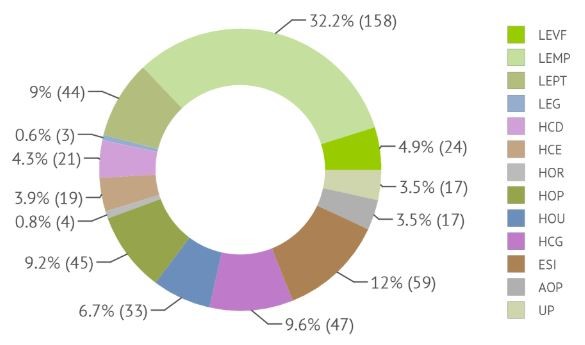Biogas is an alternative to conventional natural gas that is produced from biomass feedstock by fermentation processes. During the last 10 years the total volumes of electric energy produced with biogas as the energy source have almost tripled. According to the data of International Renewable Energy Agency IRENA, in 2016 this value comprised 87500 Gigawatt hours globally. The object of the present review is to provide information on patenting trends in the field of biogas production in 2016. For this purpose the data was summarized from 269 patent applications published in that year and related to the technologies of primary preparation of feedstock, the biogas production process itself, as well as the final product treatment, storage and transportation. The largest share of the collected documents was published by the United States Patent and Trademark Office (USPTO, 20.8%), the European Patent Office (17.1%), China National Intellectual Property Administration (13.4%) and the World Intellectual Property Organization (12.3%). According to the data in our disposal, in the previous year these offices were leading in terms of the number of published patent applications as well, although the Chinese patent office was more popular among applicants. Distribution of patent applications published by the top 10 patent offices is provided below. IRENABiogas is an alternative to conventional natural gas that is produced from biomass feedstock by fermentation processes. During the last 10 years the total volumes of electric energy produced with biogas as the energy source have almost tripled. According to the data of International Renewable Energy Agency
Distribution of documents by patent offices
| Patent office | Number of documents | Share of total, % |
|---|---|---|
| United States Patent and Trademark Office | 56 | 20.8 |
| European Patent Office | 46 | 17.1 |
| State Intellectual Property Office, China | 36 | 13.4 |
| World Intellectual Property Organization | 33 | 12.3 |
| National Institute of Industrial Property, Brazil | 17 | 6.3 |
| Japan Patent Office | 13 | 4.8 |
| Korean Intellectual Property Office, South Korea | 12 | 4.5 |
| Canadian Intellectual Property Office | 9 | 3.3 |
| Intellectual Property Australia | 9 | 3.3 |
| Federal Service for Intellectual Property, Russia | 6 | 2.2 |
| All other offices | 32 | 11.9 |
40% of the documents reviewed were filed by the applicants in patent offices outside their countries of registration. Among such offices the United States Patent and Trademark Office was the most popular with non-residents taking part in 68% of patent applications, and the Brazilian patent office, where 100% of applicants are non-residents.
77.7% of the patent applications reviewed have a patent family, 2.2% are represented as a pair of application and patent, while 20.1% of documents are single patent applications, which do not have family or pair.
Among the IPC classes that appear in this collection of patent applications C12M class is the most frequently met. It appears in 26% of documents and represents technologies that involve management of enzymes and microorganisms. It is followed by C02F (22%), representing the processing of waste waters of different kinds.
The majority of technical solutions disclosed in the reviewed patent applications comprised methods and procedure algorithms (198 documents), as well as descriptions of devices (178 documents). A much smaller number of documents (37) described materials and compositions thereof. 49.1% of the documents disclose only one kind of technical solution; 48.3% of cases include the combination of two kinds of technical solutions, while the remaining 2.6% disclose all three kinds.
Generally patent documents to some extent are aimed at resolving some type of problem. The diagram below represents how the problems are distributed in the present collection:

LEVF - Low efficiency / Variety of feedstock; LEMP - Low efficiency of main processes; LEPT - Low efficiency of product treatment; LEG - Low efficiency in general; HCD - High CAPEX / Development; HCE - High CAPEX / Equipment; HOR - High OPEX / Repair and replacement; HOP - High OPEX / Poor performance; HOU - High OPEX / Utilization; HCG - High costs in general; ESI - Environmental and social impact; AOP - Administrative and organisational problems; UP - Unclear problem
Technical solutions proposed in the reviewed patent applications relate to various stages of biogas production process chain. 46% of the documents (123 applications) contain a description of the main process in biogas production technology, namely – anaerobic digestion. 27% of the documents are dedicated to additional treatment of final product to achieve its compliance with commercial standards; 21% of the documents – to the preliminary treatment of the feedstock used in biogas production. Other stages of process chain are represented by a smaller number of documents – about 12% and less.
The diagram shows that 158 patent applications resolve the problem of low efficiency in main biogas production processes or related problems (32% of all problems found in the present collection of documents or 59% of all reviewed documents, considering that some documents refer to several problems). Other problems are mentioned in the documents less frequently: 59 applications are aimed at resolving problems related to environment protection; 47 documents concern reduction of costs of technology in general; 45 – reduction of operational costs related to technical and performance parameters of equipment; 44 – improving efficiency of final product treatment processes.
More detailed information on the methodology as well as on the results of patent researches in the most important fields of contemporary energy industry can be found at www.aenert.com
